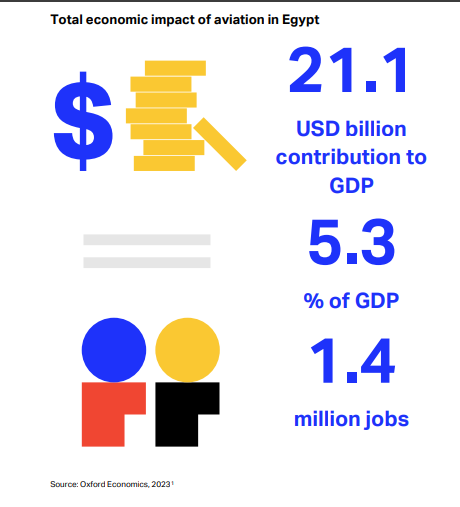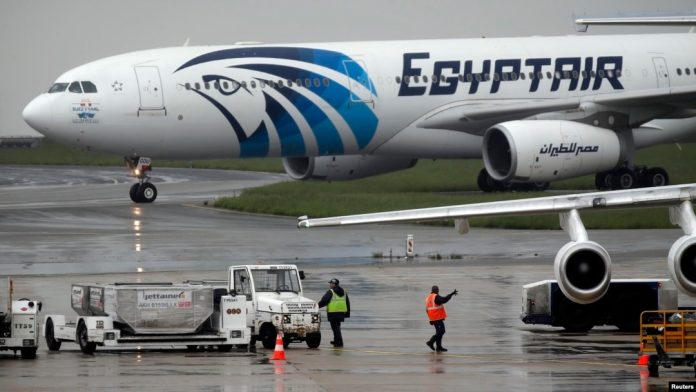A new study by the International Air Transport Association (IATA) underscores the vital role aviation plays in supporting Egypt’s economy, job creation, and global connectivity. The data, based on 2023 figures, reveals that aviation—including aviation-related tourism—contributed an estimated USD 21.1 billion to Egypt’s economy, representing 5.3% of the country’s Gross Domestic Product (GDP). This total includes the direct impact from airlines, as well as the broader supply chain, employee spending, and tourism-related activity.
The report also offers detailed insights into Egypt’s international air travel patterns. In 2023, international air traffic accounted for 86% of total origin-destination departures, with 17.2 million international passenger departures recorded. The Middle East was the top regional destination, accounting for nearly 8.5 million passengers (49% of the total). Europe followed with 6.7 million passengers (39%), and the Asia-Pacific region attracted 713,300 travelers (4%).
The sector also supported approximately 1.4 million jobs across the aviation value chain, including tourism. Of this figure, 32,800 people are directly employed by airlines. In addition, Egypt handled 338,600 tonnes of air cargo in 2023, reflecting its position as a key logistics and trade hub in the region.

Kamil Alawadhi, IATA’s Regional Vice-President for Africa and the Middle East, highlighted the strategic importance of the aviation sector following a meeting with Dr. Sameh Elhefny, Egypt’s Minister of Civil Aviation. Alawadhi noted the government’s active use of aviation as a tool for economic and social development. He welcomed the minister’s commitment to continuing close cooperation with IATA in advancing global standards and best practices across areas such as safety, sustainability, cost-efficiency, and workforce development.
To maximize aviation’s long-term benefits, IATA identified three core priorities for Egypt:
Cost-Efficiency:
With ongoing investments in airport infrastructure—including Cairo International, Borg El Arab, and Sphinx International Airports—IATA urges the Egyptian government to work closely with airline operators. By following global best practices, Egypt can avoid passing excessive financial burdens onto airlines and passengers, helping to maintain affordability and encourage travel.
Sustainability:
Egypt is making notable strides in its sustainable aviation efforts. IATA commended the country’s partnership with the European Bank for Reconstruction and Development to build capacity for producing 120,000 tonnes of Sustainable Aviation Fuel (SAF) annually. This aligns with Egypt’s Vision 2030 and the broader industry goal of achieving net-zero carbon emissions by 2050. Such initiatives position Egypt as a leader in the region’s transition to greener aviation.
Capacity-Building:
A skilled workforce is essential to ensuring the resilience and growth of the aviation sector. From technical op
erations to digital innovation and environmental sustainability, developing a future-ready workforce will enhance safety, efficiency, and long-term success.

Egypt has experienced significant improvements in air connectivity over the past decade. Since 2014, the country’s international air connectivity index has risen by 17% within Africa and by 89% with other global regions. While 1% of international arrivals connected to domestic flights, the majority—92%—ended their journey in Egypt or continued travel via another mode of transportation. Additionally, 7% of arriving international passengers used Egypt as a transit point to reach a third country.
Cost remains a key factor influencing air travel accessibility. Over the last 50 years, global flight costs have dropped by 70%, making air travel more affordable. In Egypt, average real airfares decreased by 13% between 2011 and 2023. On average, Egyptians now need to work 15.7 days to afford a plane ticket. In 2023, there were 177 flights taken per 1,000 people in the country.
The IATA report affirms that aviation is a critical enabler of Egypt’s economic growth, international engagement, and development goals. With strategic investment, collaboration, and policy support, the sector is well positioned to continue driving progress in the years to come.













